I’m now going into my third summer as the owner of a Defiance Yellowtail 195. This boat is a huge upgrade in a relatively small package from my old 18′ Westerner Bayrunner. It is a boat that often thinks it is bigger than it is, delivers on what it is and is a joy to regularly use.
In this review:
Fishability – Key for a Fishing Boat Review
The Boat and Layout
This is a small fishing boat/skiff designed to fish the left coast of the US. Defiance Boats are located at Pt. Defiance outside of Seattle, WA where rain and wind are common. Contrary to popular belief, Southern California isn’t warm all of the time and these boats fit in nicely here.
Most avid anglers like center consoles because of the 360-degree fishability. When you add a cabin in the form of a walk around or a pilothouse, you make a compromise. So why would you want a pilothouse on a boat so small? Well, for protection from the elements. First, my previous boat was an 18′ aluminum Westerner Bayrunner. A great boat, but you wear your foul weather gear the whole time. On your average day here, you get wind, spray and a bit of cold. Yes, cold. While Southern California is relatively far south, the water here gets its nutrients from the deep water and the California current which comes down from Alaska. For a month or so, the water may get above 70 degrees, but even in the summer, it is not uncommon for water to “roll” and dip below 60. Wind on 60 degree water for any length of time is cold. So, the pilot house provides protection from the elements. Protection from the wind, rain and sun are great features of this boat.
What about the compromise? Yes, you loose 360-degree fishing access because of the pilothouse, but Defiance did a great job of leaving some space to walk around it. This boat has a custom waist-high bow rail which makes fishing up front very comfortable even in the big swells. The next nice thing is that Defiance pushes the house way forward leaving a lot of space for the cockpit. By mounting the motor on a bracket, cockpit space is maximized and you get a closed transom protecting you more from waves over the stern. The sides of the cockpit are high enough that you feel secure in the boat, but you don’t feel oddly high from the water either. All in all, you get a very usable fishing platform with some larger boat features.
This is only a 20′ fishing boat. The cockpit is one area that it tends to think it is a little bit bigger. Even when staying just in the back of the boat, there is room for two people to cast. Three is doable and when one is on the bow, it works well.
I do a combination of fishing plastics and fishing bait. Mostly I fish plastics. Casting artificial plastics is one of my favorite things to do. This boat handles that well and it was one of my concerns when I got the boat. In addition to the large cockpit, the boat will drift sideways to the wind. Most outboard boats will point their stern into the wind. The pilothouse starts to act as a sail and by turning the motor hard over, you can steer it to drift sideways. This is great for all types of fishing.
With ample space for a 20′ fishing boat, being able to duck out of the sun or wind is great. While not a family boat, there is a little cabin that the kids love. I’m 5’10 on a good day and when I lie in the cabin my feet stick out. You can overnight on it, but it is not a five-star hotel. I try to keep the cabin cleaned out, but it does provide great dry storage for gear and things.
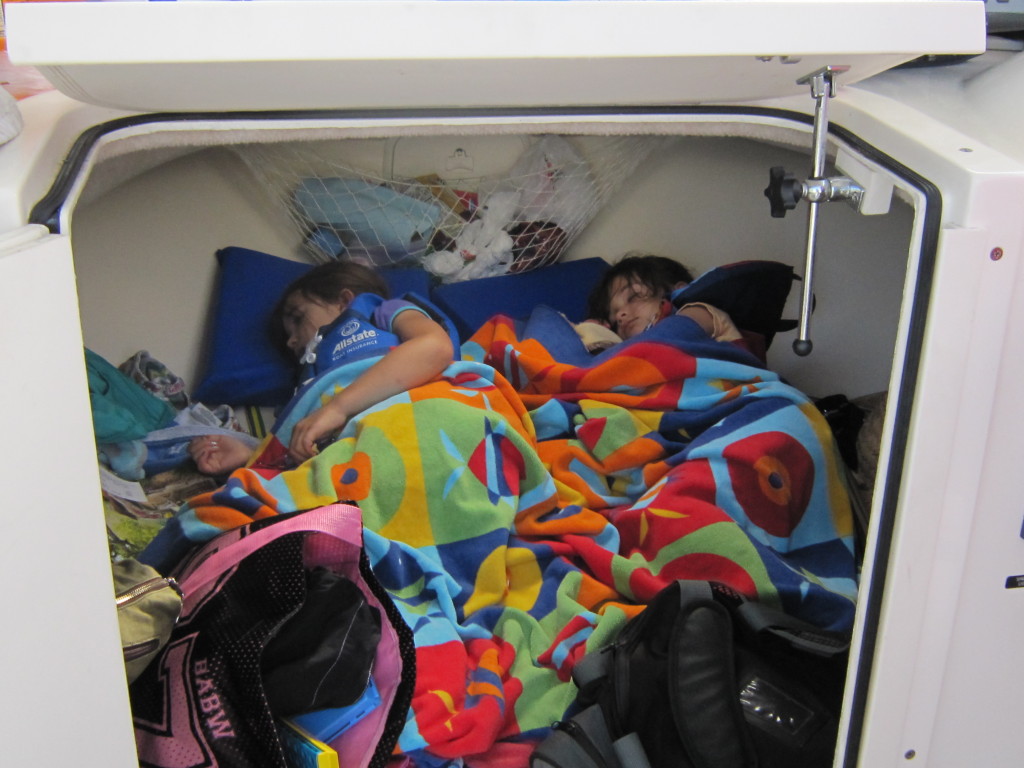 I should also mention that the house is nice, but it is not designed for tall folks. I think up to about 6′ tall would be ok in it, but my tall friends need to duck down.
I should also mention that the house is nice, but it is not designed for tall folks. I think up to about 6′ tall would be ok in it, but my tall friends need to duck down.
The Ride
The boat is lite and a bit narrow with a deep V hull. It knifes through chop and generally lands softly when coming off bigger waves. Again, this is a small boat, but the ride is pretty nice. I don’t get beat up too often and it has handled some pretty rough stuff.
One characteristic of the boat you notice it can be “tippy” when not moving. The deep V is great for slicing though waves, but when you aren’t moving, the boat likes to tip 20-degrees (hull’s deadrise) either way until that side becomes flat and level. It is sort of like a teeter totter and for some it can take a bit to get used to.
That tippiness also means the trim tabs are very valuable while running. Either due to wind or gear placement, I’ll often need to trim one side a bit to keep things level and comfortable. Should I be pounding directly into it, a little bow down makes the ride pretty nice.
Going down swell can take a bit to get used to. To maximize the cockpit space, you are driving pretty far forward. I liken it to a n old VW bus. Add that to the view of coming over a 3-6′ swell and it can feel like you are going to fall into a huge hole. But, the deep V and the flared bow keep the ride nice and comfortable. That said, I find this boat runs well in all directions relative to the swell.
The boat is pretty dry. I know that is an odd comment to make about a pilothouse as that is the purpose of the house. But, the hull itself does a great job of knocking down spray. Yes, we do get spray into the windows every now and then and I appreciate them immensely. But, compared to other fishing boats I’ve ridden around here, a lot less water comes back that could spray you. This also keeps the corrosive salt water off your gear which is a bonus.
Fishing
I think I’ve hit on a lot of the key points here already. The boat fishes well. It is small and nimble for things like being tight to the rocks or holding position over a stone. It drifts very well and has great space for casting. There is no question that it is designed for fishing.
I would not say this is a great rig for tolling. It is right at the size where it is fighting a plane for a lot of the offshore trolling targets, so economy goes down. For slow trolling live baits, it is great.
I also like to lobster Southern California style with this boat. It almost seems like it was designed to be a mini-lobster boat.
All in all, it is pretty easy to configure this for your fishing style and it is comfortable to fish from.
Running and Economy
This is a 20′ fishing boat with a 115 HP Yamaha 4-stroke. In my opinion, with the bait tank, railing and some people, it is a little underpowered. Getting up onto a plane with a load or into bad wind chop can be a little slow. Once there, it goes pretty well.
I’ve been keeping stats on fuel burn and fuel flow pretty much since I got the boat. San Diego Boats installed a fuel flow gauge for me which is a great tool.
Cruising speed is from 16-20 knots. Full speed is about 30 knots.
Since I got the boat in 2010, I’ve put roughly 630 hours on the motor, burned 1,100 gallons of gas and averaged just over 3 nautical miles per gallon. Loaded with people and gear in big waves, that will drop. In the bay, it goes way up. The average trip is 10-15 gallons of gas making this an economical boat to use. Averaging over 300 hours per year, it does get used.
I played with props a lot and currently use a 4-blade aluminum 15″ prop. I moved the motor up a notch that also seemed to help.
See the table and graph at end for more on performance.
Details and Specifications
From the manufacturer’s site:
Specifications
| Standard | Metric | ||
| Dimensions | Length (w/bracket) | 20′-7″ | 6.3 m |
| Length (from bow roller to engine) | 23′-6″ | 7.2 m | |
| Transom height | 25″ | 0.6 m | |
| Beam | 7′-8″ | 2.3 m | |
| Draft | 15″ | 0.4 m | |
| Standard | Metric | ||
| Capacities | Fuel tank capacity (2 tanks total) | 50 gal. | 189 l. |
| Water capacity | NA | NA | |
| Standard | Metric | ||
| Weights | Weight (w/ standard power) | 2,050 lbs. | 929 kg |
| Deadrise | Deadrise at transom | 20° |
Features
| Standard | Optional | ||
| Fishing extras | Raw water washdown (w/ hose & nozzle) | O | |
| Stern rail stainless steel | O | ||
| Side rails (2) stainless steel | O | ||
| Comfort | Kicker motor bracket | O | |
| Boarding ladder stainless steel | O | ||
| Electric windshield wiper (port) | O | ||
| Bow pulpit (w/ roller) | O | ||
| Port-a-potty | O |
My Options and Customizations
The boat was a bit of a showroom model so I got it dialed with the nice railings that I think are a huge part of the overall package. Ultimately, I added the bait tank and electronics to have it fish ready. I’ve tweaked and improved a bunch of things, but that is part of dialing in your boat for your fishing style.
- Raw water washdown
- Custom Stern Rail
- Custom bow rail
- Custom cabin top mounted rod racks with light brackets
- 40 gallon fiberglass bait tank – Big Salt tank that is great. It even has a light in the bottom. It is not the reason my bait ever dies (and it rarely does).
I’ve added a number of rod holders where they make sense which has also increased the fishability. Some are to hold rods, some are for fishing and some to hold gear (bait table, bait net, gaff etc.) The cabin top mounted rod racks are only set back 5-degreess so they don’t hang over the the cockpit much (good for casting space). I’ve mounted some rod holders to the bow rail angled forward to also keep then out of the way for casting.
In the electronics department, I went with a Lowrance HDS-8. At the time, it was the best 8″ model with a focus on fishing. It is a great tool that I’ve added radar and sidescaning sonar too which just make the overall packaged better. For a VHF, I got an ICOM M422. I also added two speakers wired to a marine amp that interfaces to my phone via bluetooth. This gives wireless sound for slow times or when running to the offshore grounds. I replaced the halogen spreader lights with LED from Coastal Night Lights which gives much better light and draws a fraction of the power.
For creature comforts, a few well placed hand holds have come in very handy both for running at speed and for when drifting in rougher conditions.
Pros and Cons
I’m trying to include as many cons as possible. I am biased as I really like this boat and it fits my needs very well. My needs are based on my current situation, so I’ll try to not influence the pros and cons with them, but obviously they are a factor.
Cons
- With the additions custom features, the 115 HP motor is a little weak. It is ok when solo, but you want more hole shot with more load or into the breeze/waves
- Can be a little tippy when not moving
- Cabin is a bit more of a storage area than a cabin
- Stern cooler was not insulated
- Batteries are in the bilge. This is common on little boats, but is a risky point of failure should you take on water.
- 50 gallon gas tank limits the range a bit, but then again, it is a small boat.
Pros
- A small boat that can do a lot with a focus on fishing
- Comfortable ride
- Great protection from elements; sun and cold
- Trailerable boat under 3000 pounds – it even fits in my driveway saving me storage costs (this was a big factor in my decision). I can easily launch it on my own too.
- Economical to run – I’ve been averaging close to 3MPG since I’ve had the boat (Nautical Miles per Gallon.)
- Composite construction, so limited rot to worry about.
Conclusion
This is a solid little fishing boat that can do a lot in the right conditions. It fishes the bay well, it fishes the local kelp well and it can run offshore when the conditions are right. The ride is comfortable and shelter from the elements is great. I can even do family cruises on it which can be a blast.
Being able to store it in my driveway (I only have an inch or so to spare) helps to make owning this boat a reality for me. Being able to tow it with a Toyota 4-Runner also helps a lot since I don’t need a dedicated tow vehicle.
There is a lot for me to like in the boat. Like all boat owners, I dream of more sometimes, but for the most part I am very happy with my Defiance Yellowtail 195. It is versatile enoughto fish every week and doesn’t break me or the bank in doing so.
↑
Images
↑
Performance
| 15″ AL 4-blade Top Hole | |||
| RPM | Flow | Speed | MPG |
| 1500 | 0.9 | 5.7 | 6.3 |
| 1800 | 1.2 | 6.5 | 5.4 |
| 2000 | 1.4 | 6.7 | 4.8 |
| 2300 | 1.7 | 7.0 | 4.1 |
| 2500 | 2.0 | 7.2 | 3.6 |
| 2800 | 2.5 | 7.6 | 3.0 |
| 3200 | 3.5 | 8.9 | 2.5 |
| 3500 | 4.1 | 10.3 | 2.5 |
| 3900 | 4.8 | 15.3 | 3.2 |
| 4000 | 4.8 | 16.5 | 3.4 |
| 4200 | 5.5 | 18.9 | 3.4 |
| 4300 | 5.6 | 19.3 | 3.4 |
| 4400 | 5.8 | 20.0 | 3.4 |
| 4500 | 5.9 | 20.7 | 3.5 |
| 4600 | 6.0 | 21.1 | 3.5 |
| 4700 | 6.3 | 22.4 | 3.6 |
| 4800 | 6.6 | 23.4 | 3.5 |
| 5000 | 7.0 | 24.1 | 3.4 |
| 5200 | 7.7 | 25.2 | 3.3 |
| 5500 | 9.0 | 26.9 | 3.0 |
| 5800 | 10.6 | 28.6 | 2.7 |
| 5900 | 10.6 | 29.8 | 2.8 |
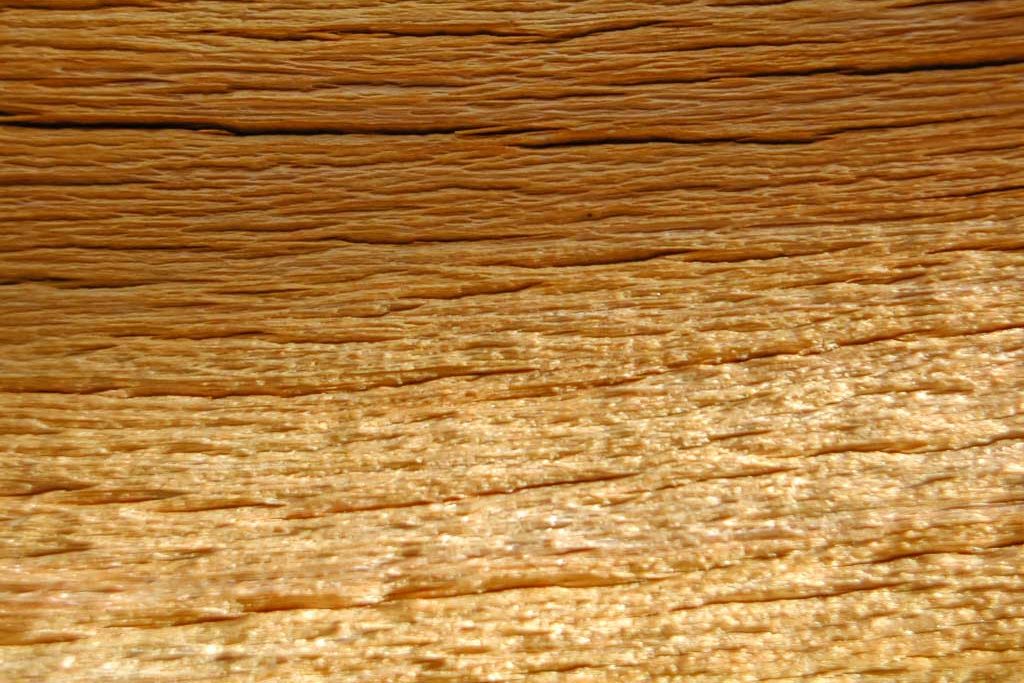
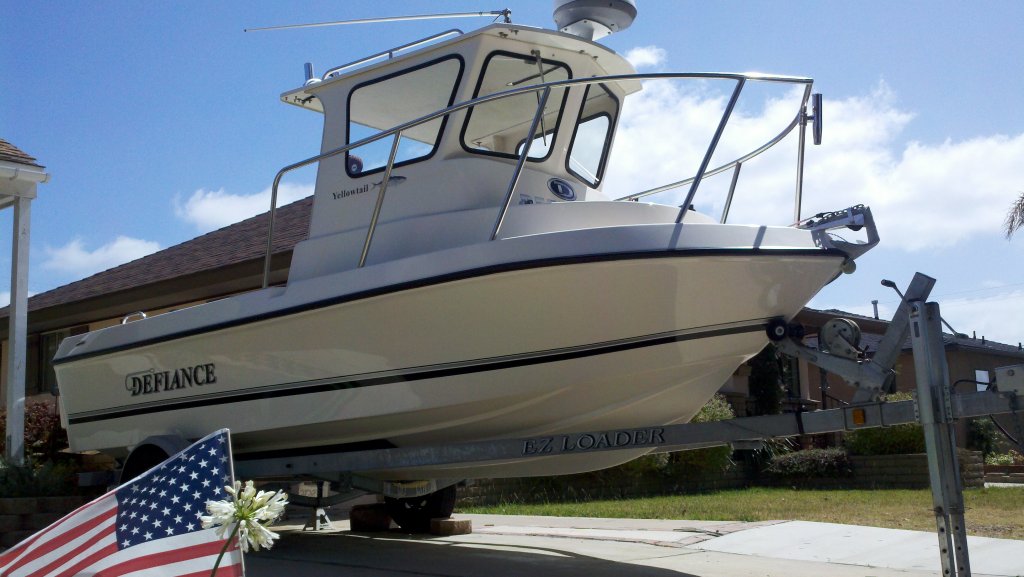
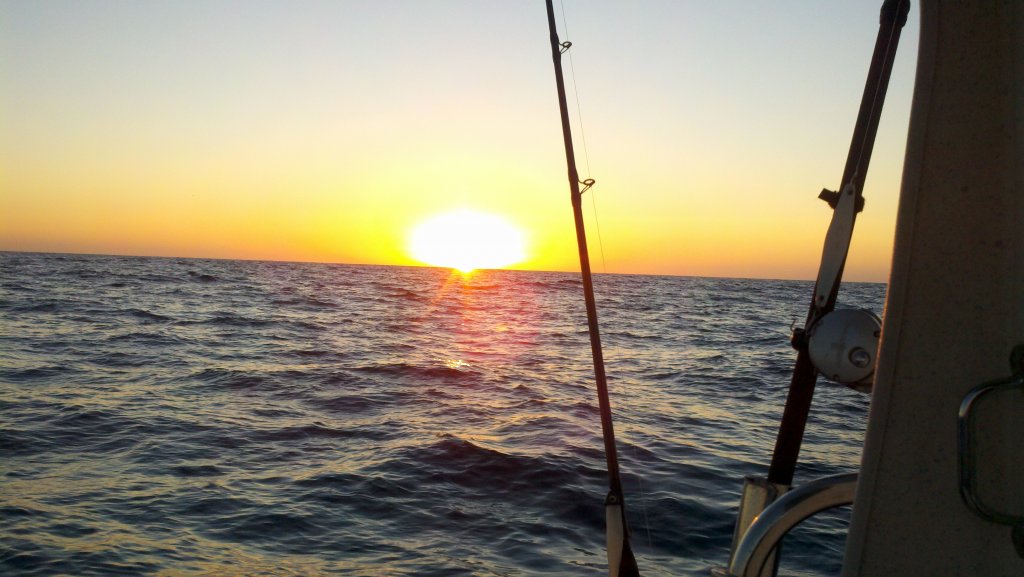
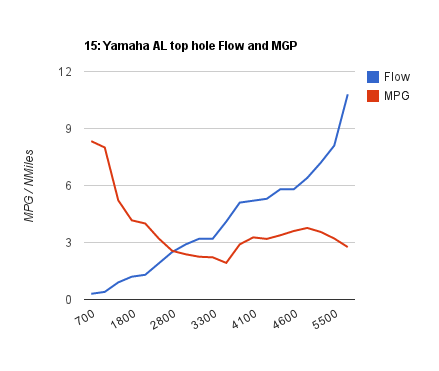
Enjoyable blog to read. Our purchase of a yellowtail feel through. I’m pretty sure ive driven past your boat many times and have always been filled with envy. If you find a note on it asking if you’re ready to sell it’s from me 🙂
You probably get this a lot but ready to sell yet?
Not yet. Says something about it though, doesn’t it?
I have 1999 Tiderunner. It is very similar to your boat with same transom bracket. I’m having trouble find trim tab that work with the transom bracket. What brand of trim tabs do you have?
They are small and cheap. Maybe 8″x10″. Still hydraulic. I find that I have to have the motor in fairly positive trim and then just use the tabs for a little left/right. When loaded, or heading into wind chop, I will put them both down.
Hi Steve, stumbled on this page a long time ago and am still a huge fan of your boat. Wanted to see if you would be interested in parting ways with your Yellowtail?
Maybe one day when I get the funds to upgrade. This is still my weekly ride.
Let me know if your ever interested in selling this boat.
Nice write up! I am looking for a small pilothouse for fishing in Santa Cruz. This seems like it would be perfect. If you ever want to sell or have leads on others let me know. Thanks!
Love your boat, but will make one comment re. the high bow rail. You can easily see those kids are NOT going over that rail–that’s great, BUT they can easily go UNDER it. I have seen people add some sort of heavy plastic or cloth material (looks great) to prevent going under. Same with the family dog–and I’ve had it happen when mine went overboard. Scared the daylights out of me–fortunately I had him on a tether–cut the engine NOW and hauled him back in.
Thanks for your input. I’m getting my pax edge 30g tank in the mail today. Excited for sure. Would you be willing to meet up so I can check out your plumbing?
Toss me an email.
Hey Steve ,
I just became owner of a used YTS and thought I would reach out to ya. What prop did you end up landing on. Mine has the standard Yamaha 115. And I can feel an issue for trolling speeds.
Matthew
With the bow rail and bait tank, mine is heavier than stock. I ran a 4 blade 15″ for a while, but it had a hard time getting to full RPM. These 115’s don’t like to lug or be under propped. I’m running the 15″ Yamaha Aluminum one now.
Ultimately, I want to move up in HP, but I don’t think that will change trolling.
The boat slow trolls ~1.5-2 knts great. Just idle speed. For jigs offshore, just realize you are doing 4.5-5 knts. Over that and you are fighting on/off plane with huge stress on the engine and marginal better wake speed. I get bit fine at those speeds. Those speeds are 90% based on water line length, so prop and motor won’t do a lot to change that (.1-.25 knots at most).
The 15″ helps the motor run better in the sweet spot (it like 4,500-4,800) in most conditions. For docking and maneuvering, I do give it a bit more throttle at times. The boat can easily spin on a dime and is easy to position for picking up hoop nets with either prop.
And congrats on the boat. It is a great little skiff that feels bigger and is fun to fish on.
I have an 07 here in sd as well. i like your bow rail, where did you get it done and if you don’t mind me asking how much did it cost
Brian – it was on there when I got the boat, so I don’t know what the break out it. I am pretty sure it was not PYT, but I don’t know who the other railing person in the SD area is. If you get one, get it this high so you can use it for balance. Easy to cast iron or bait from up there.
Great write up. I really like the layout on this boat. I live in Seattle and for some reason we just don’t have a lot of these around. There are a number of the larger models and they are very popular offshore for tuna. If you are selective on your days you can easily run for tuna in this machine. I might put a 150hp on the back but other than that you are set for three guys and it would be very economical I would think. The tiderunner is the same hull just missing the pilothouse. It would also be nice to have some hatches installed in the hull for fish storage, maybe turn the bait tank. You could put 20 albacore between a deck bag and hull storage. Thanks again.
I’ve thought about most of your suggestions. There isn’t much room for hatch storage as it is foam filled (USCG). With the railing and bait tank, it needs the 150. My 115 blew the oil pump and it may be since it is lugging to much (115’s get oil in the gas when the lug). I’ve even got the lowest pitched prop which tells me I’m underpowered. 3 guys with the 115 isn’t fun offshore, the 150 should solve that. I talked to the owner, and they stopped making this size as they have the Arima line for small pilot houses now. Most of the 19.5 yellowtail’s are in Southern California from what I know.
We did have it plugged with about 20 YFT this past summer. I really wanted the 150 on that 20 mile run home.